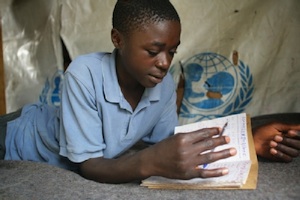The International Labor Organization states that 1.2 million children are trafficked each year. Other organizations claim even higher stats of 2-3 million. Despite increased interventions worldwide, the industry that buys and sells children remains horrifyingly lucrative. Take a country like Bulgaria where the average annual salary is $2300 but a girl sold into prostitution can earn up to $23,500, illustrating how, in an ill global economy bathed in uncertain socio-political conditions, illegal commerce finds a way to thrive off the most vulnerable. Children are most often sold into forced labor, sexual exploitation, armed forces, drug trade and child begging. It can be argued that forced child marriage is also an off shoot of the same issue, as young girls are often subjected to a life of poverty, subservience and dependency similar in nature to the above mentioned industries. In essence child trafficking is the “recruitment, transportation, transfer, harboring, and/or receipt” of a child for the purpose of exploitation.
Human rights organizations have dissected the personalities behind such a heinous profession to find that child traffickers are well connected, resourceful, and cunning in their methods. A three tier system of force, fraud and coercion is applied in order to gain and control victims. What starts as a promise for a better life turns into a debt trap, in which children are used as the bargaining chip for everything from settling scores to clearing family loans.
The problem of child trafficking has many levels; from governments to gangs. Therefore, the solution must also be a multilevel one with participation not only from policy makers but also corporations and communities. Several entities worldwide are currently working to combat child trafficking in all its forms and across all its borders.
The United Nations along with other Human Rights organizations has been paramount in bringing the issue of child trafficking to the legislative level, but there are also many grass roots initiatives that are applying unique and affective ways to help eradicate child trafficking. These “small scale” solutions have the potential for large scale results, if they have the man power and support to fuel them.
From a preventative perspective, UNICEF has introduced “Meena” India’s Dora the Explorer, the cartoon poster girl for the promotion of child rights in India and Bangladesh. Since she first took to the airways in 2010, Meena has been addressing social and public health concerns facing the children of the region. The cartoon deals with these issues to not only create awareness amongst potential victims but to also fuel socio-cultural change amongst people at large. To some, approaching such a serious issue through a cartoon may seem juvenile, but this seems to be the very reason the project has been successful; presenting a child’s crisis through the medium of a child highlights the innocence and vulnerability of victims and stretches society’s moral fabric. To apply this strategy specifically to the matter of child trafficking would surely help to get children’s voices heard through an accessible, media driven mouth piece.
Although individual concern and participation are essential, to incorporate the corporations is also a major piece in the battle against child trafficking. When companies outsource or contract internationally, they must be aware of labor practices. Vendors that use child labor to produce their goods need to be boycotted until they clean up their human rights record. However, to inspect such practices is a responsibility that will primarily fall upon the shoulders of the corporations themselves, as vendors will not willingly open their doors to inspections. Gap, Coca-Cola and Hewitt Packard are all examples of corporations that operate on a “code of vendor conduct” and have made active attempts to clean up their product supply chain. These companies have conducted investigations and denied products made by child labor to enter their markets by nixing contracts with companies who have unethical labor practices.
In the matter of child marriage one of the most astounding initiatives is a group of young Bangladeshis, children themselves, making headway in tackling this issue on their streets. They call themselves the “Marriage Busters.” This group monitors “matchmakers’ as they enter homes in order to negotiate potential husbands for young girls, the majority of whom are younger then the legal marriage age. Marriage Busters then approaches these same homes and opens dialogue with parents, attempting to convince them of the evils of child marriage as well as guide them to other opportunities for their children. The group has enjoined much success and is now being endorsed my local politicians “The wedding busters succeed because it is part of a community-based, bottom-up approach,” said Shamsul Haq, a local council chairman. “We bring together the government, elected representatives and NGOs like Plan Bangladesh, and work with a comprehensive approach. You can’t defeat something like this with heavy-handed law enforcement.”
Finally, on an individual basis the idea of “becoming a billboard” and “writing for rights” are popular methods being employed in order to become a part of the solution. Becoming a billboard entails wearing articles of clothing and accessories that carry messages related to child trafficking on them. Many groups have begun to produce such merchandise in an attempt to initiate public dialogue about this matter. Add to this the voices of thousands of journalists, writers, bloggers and social media users and you have a good starting point to push the issue of child trafficking as far out in the open as possible. The underlying idea behind each and every initiative to stop child trafficking is that knowledge creates understanding, empathy and ultimately the desire to facilitate change.






























Comments